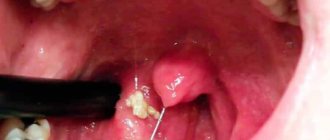You've probably experienced this - your nose gets very stuffy when lying down, it's hard to breathe, when you get up - the condition improves. Such congestion is very uncomfortable and can lead to weakness, insomnia, headaches and even disrupt the functioning of other organs, since it does not provide a high-quality oxygen supply.
This condition should alert you, especially if you do not have a cold or runny nose. Indifference in this matter can lead to complications. The doctor will help determine the causes of the disease and recommend treatment.
Causes of nasal congestion when lying down
- vasomotor rhinitis;
- deviated nasal septum;
- cyst in the nasal area;
- allergy;
- inflammatory processes in the nasal sinuses;
- poor environmental conditions of housing;
- foreign body entering the nose;
- impaired vascular tone;
- hormonal changes;
- age-related changes in the mucosa;
- taking medications.
- sinusitis;
- ARVI and colds;
- postnasal drip syndrome;
- adenoids or polyps.
Let's start with the causes caused by infections. The most common is ARVI, when a person simultaneously develops fever, runny nose, chills, weakness and headaches.
As a rule, all symptoms, along with nasal congestion, disappear by the fifth day. At the same time, discomfort both in a horizontal position and in any other position is around the clock, but it is especially expressed when the patient is lying down.
Infectious causes of nasal congestion can be:
- ARVI and colds. The nasal mucosa becomes the first to take the hit of viruses or bacteria. If local immunity does not work, the infection attacks the mucous membrane and causes an inflammatory process, which develops into swelling of the sinuses, runny nose, severe congestion, and headaches.
- Sinusitis. Inflammation of the nasal paranasal sinuses. If the symptoms of the disease (and primarily the runny nose) are treated incorrectly, as well as complications after viral diseases, sinusitis (inflammation of the maxillary sinus) or frontal sinusitis (inflammation of the frontal sinus) may develop. Then the discharge becomes purulent, discomfort or pain appears in the sinuses, the temperature rises, the condition becomes severe, it is impossible to breathe, heart pain, tachycardia, and other side effects may occur. Nasal congestion when lying down can be complete, or one nostril may be blocked if the inflammatory process is one-sided.
When viruses or bacteria are activated, they provoke changes in the soft tissues of the respiratory tract: an inflammatory process begins in the mucous membranes, swelling of the nasopharynx, and difficulty breathing. Because of this, pain in the back of the head, cough, and weakness appear.
But if there is no respiratory infection, but the nose is stuffy, creating discomfort, this may indicate other problems. They are no less serious and will have to be resolved with a specialist. Congestion may appear at certain times of the day and change with changes in body position. Well, if you can monitor this and tell the doctor, then it will be easier to diagnose the disease.
In addition to infectious rhinitis, there is vasomotor rhinitis. It appears if there are disturbances in vascular tone. As a result, inflammation of the mucous membrane and copious discharge with nasal congestion begins. If vasomotor rhinitis becomes chronic, this can lead to asthma.
Vasomotor rhinitis can appear due to the following reasons:
- Exceeding the course of treatment, the use of drops that constrict blood vessels. Over time, to get rid of a runny nose, the patient needs an increasingly larger and larger dose of the drug. In this case, “medicinal rhinitis” may develop, in which the nose stops breathing in any position.
- Stressful situations. Without a runny nose, the nose may become stuffy when lying down in people who are experiencing severe stress or in people with a heightened emotional background.
- Unfavorable environment. Polluted air gradually leads to the development of rhinitis. In the respiratory tract, as the primary barrier of the body, many harmful substances accumulate and, as a result, swelling of the nasopharynx.
- Eating very hot or spicy foods.
- Problems with the cardiovascular system. If there is increased pressure, more active filling of blood vessels occurs, including in the nose. This can also cause problems in the respiratory system and congestion, especially when lying down. When a person lies down, blood flows more actively to the head, even in healthy people.
- Taking certain medications, for example, for hypertension.
With vasomotor rhinitis, the nostril on which the person lies is blocked in a horizontal position. If you turn over, the same thing will happen, only with the other nostril. If you stand up, the swelling goes away and your nose begins to breathe.
There are many other causes of nasal congestion when lying down.
Adenoids
Nasopharyngeal tonsil, which can cause inability to breathe through the nose, as well as hearing loss. In childhood, this problem is especially pronounced when the child begins to get sick often while attending kindergarten. During illness, lymph greatly increases as it becomes a defense against viruses. Therefore, most operations to remove adenoids are performed at an early age. Adenoids can also enlarge in adults under 30 years of age. When this happens, breathing through the nose becomes impossible, and this is especially aggravated in a lying position.
Nasal polyps
These are benign neoplasms that are inherited, after infectious diseases or allergic reactions. When polyps appear, it becomes impossible to breathe, especially at night, during sleep. In addition, polyps can subsequently develop into asthma or cancer.
Allergy
Every person is constantly faced with many allergens. But if there is a malfunction of the immune system, then any plant, dust, wool and other, even the most unexpected substances can be perceived as enemies. Then the immune system begins to produce antibodies, which accompany the development of the inflammatory process in order to protect the body. But for humans, this protection turns into painful allergy symptoms: sneezing, tears, nasal congestion.
If this congestion begins only when a person finds himself in his bed, then it is worth thinking about the presence of dust mites, which often live in mattresses, blankets and pillows.
Workers who spend long periods of time in damp or dusty areas may develop allergies to household dust.
Such a disaster usually befalls library and archive workers. If there is mold on the walls of an apartment, it can cause a serious illness, the most harmless of which will be an allergic reaction. True, over time it can develop into big problems.
There is a concept of cumulative allergies. This is a human reaction to some substances, which does not appear immediately and can accumulate for years, and then express itself when the immune system fails.
Severe nasal congestion, especially when lying down, is caused by allergic rhinitis during the flowering of some plants and pollen.
Dry air in the home
When a person experiences congestion exclusively at home, it may be due to dry air in the apartment. It is necessary to pay attention that good ecology of housing is maintained by regular wet cleaning and high-quality ventilation. Air humidity should be at least 60%. Often, when seasonal heating appears, humidity decreases to 30 or even 20%, this is extremely low and is harmful to health. If the humidity is less than 60%, you need to put bowls of water, hang a wet towel or buy a humidifier.
Dry air harms the normal functioning of the body and it causes the following problems:
- increased drowsiness;
- poor health and constant fatigue;
- stuffing the nose in a horizontal position.
Poor nutrition
If a person’s diet contains a high content of sugar, preservatives, and smoked foods, the body may respond with nasal congestion.
Hormonal disorders
Nasal congestion can occur with any hormonal changes:
- when discontinuing a hormone-containing drug;
- during puberty in adolescents;
- during pregnancy, when hormone production increases;
- for endocrine diseases - thyroid gland, adrenal glands).
- during age-related changes.
Nasal septum deformities
A deviated septum can be anatomically hereditary, or it can be acquired during the growth of the cartilage and bone parts, which in children can develop unevenly, causing layers that lead to breathing difficulties.
A curvature of the septum can occur due to an injury to the nose, then it blocks one of the nasal conchas, causing a runny nose or nasal congestion.
A deviated septum usually causes a person to:
- difficulty breathing;
- dry nasal mucosa;
- snoring during sleep;
- burning;
- bruising;
- problems with the cardiovascular system;
- some ENT diseases.
Foreign body entry
Most often, pediatricians encounter this.
Kids can stick a button, a construction piece, or any other small object into their nose. The danger of small parts is that they can get into the bronchi, which already poses a danger to life. Some adults, for the purpose of alternative treatment, can stick a plant leaf, a cotton swab with ointment, or a piece of onion or garlic into their nose. Any foreign object will cause swelling of the mucous membrane and blockage of the nose; the situation will be especially difficult at night, during sleep, if the person did not notice penetration inside.
Postnasal drip syndrome
Mucus is constantly produced by special glands located in the nasal cavity. Mucus is designed to moisturize the mucous membrane and protect the body from viruses. Under the influence of certain factors, mucus may begin to be produced in large quantities and constantly flow down the back wall, clogging the openings for air intake.
What does it mean if your nose is stuffy but there is no snot?
A runny nose in a child is a common occurrence with the flu and acute respiratory infections. It goes away after recovery. However, if nasal congestion is not accompanied by snot, many parents become confused. This problem especially bothers children at night while sleeping. Why is the nose stuffy, but there is no snot (we recommend reading: a child has a stuffy nose without snot)? Let's consider the main reasons for this condition:
- Chronic vasomotor rhinitis. This pathology can develop as a result of improper treatment of various diseases, for example, with prolonged uncontrolled use of vasoconstrictors. The muscular walls of blood vessels stop responding to external stimulants, and the nasal mucosa becomes sensitive to any irritants.
- Allergic reaction. Most often, allergies are accompanied by lacrimation, sneezing and copious mucus production. However, sometimes the body reacts to an allergen only with nasal congestion. This reaction can be caused by pet hair or bird feathers, dust, mold, and insects.
- Sinusitis. Swelling of the mucous membrane occurs due to inflammation in the paranasal sinuses. The disease develops against the background of a cold and is accompanied by headaches and increased body temperature.
- Congenital anomalies of the nasal septum. The pathology may not manifest itself for several years. Over time, narrowing of one or two nasal passages occurs, which prevents the normal flow of air.
- Violation of the structure of the nasal passages due to trauma.
- Polyps. New growths appear in children who often suffer from infectious or colds. The body tries to protect itself from pathogenic elements by increasing the volume of the mucous membrane. The growths take a long time to form.
- Adenoids. Inflamed tonsils can completely block the nasal passages.
- Foreign body. Kids often try to stuff small beads, construction kit parts, berries and leaves into their noses. Parents need to closely monitor their child when he is playing. Long stay of a foreign object leads to inflammatory processes. Pulling them out on your own is dangerous, as you can push the object deeper, which will damage the nasal septum or cause an attack of suffocation.
- When the air in the children's room is dry, babies get stuffy noses, but there is no mucus.
- Tumor process of ENT organs.
- Long-term use of medications or hormonal drugs that have a vasodilating effect.
- Pathologies of the kidneys, cardiovascular or endocrine systems can cause circulatory problems in the mucous membrane and cause swelling.
- Some children react with nasal congestion to a sudden change in environment.
Diagnostic measures
A specialist called an otolaryngologist or ENT doctor will help you find out the reasons why congestion occurs in a lying position. A detailed survey and examination using special instruments will determine the structure of the nose, the presence of inflammation and other problems. If you need to clarify the condition of the internal sinuses, the doctor may prescribe an x-ray, MRI or CT scan. To understand the degree and characteristics of the inflammatory process, a general blood and urine test, as well as a biochemical analysis, are prescribed.
If an ENT doctor sees manifestations of an allergy, he will refer you to an allergist. During the examination, he is tested for an allergic reaction and the allergen is determined.
Therapy of neurogenic (or vasomotor) rhinitis is carried out using electrophoresis or ultrasound. A referral for cryotherapy is also possible.
All these procedures are natural for the body and safe and help deeper penetration of drugs into tissues, while immunity is increased, mucous secretions are better removed, and lymph microcirculation is normalized. And as a result, nasal congestion goes away even in a lying position.
Methods are selected only by a specialist doctor, based on the individual characteristics of the body and concomitant diseases. They may be limited to physical procedures, or they may be medicinal.
How to get rid of nasal congestion
Traditional medicine can help ease the condition of the body and your sleep. But if you decide to treat a runny nose with folk remedies, then you must not forget that as the disease progresses, it is important to seek help from a specialist.
So, let's list some folk remedies to ensure that your nose breathes well without taking medicine or drops:
- A hot foot bath will help reduce swelling of the nasal mucosa.
- Kalanchoe flower juice - thanks to continuous sneezing, viruses and snot will come out of the body.
- Essential oils of lemon and mint can relieve nasal congestion. Apply a couple of drops to your pillow before bed.
- Various solutions open up the nose well, but not right away. It takes some time. This is a solution of chamomile infusion or a solution of sea salt.
- Drink plenty of warm drinks from medicinal herbs (honey, sage, milk, raspberries).
- Massage – carried out in the area of the bridge of the nose and sides of the nose until you feel warmth.
- Horseradish root, which is grated and laid out in a cloth, is wrapped in several layers and applied to the nose. The compress should be kept for at least 10 minutes. This procedure will warm the nasal passages well and act as a bactericidal agent.
- Balm “Zvezdochka” has an unpleasant, pungent odor, but it is harmless and effective.
- An excellent way to combat a runny nose is inhalation. It is very important not to go outside after the procedure.
The above cases of nasal congestion at night concern adults, but what measures should be taken if a child’s nose is stuffy?
How and with what to treat
Therapy will depend on the disease itself and the cause that caused it.
Treatment methods include medication, conservative and surgical.
Vasomotor rhinitis is treated in the following ways:
- rinsing the nose with saline solution;
- hormone-containing drops;
- hardening;
- foot baths.
If this does not help and the condition of the nasal turbinates requires more serious treatment, a vasotomy is performed - dissection of the connection between the mucosa and the periosteum, which alleviates the patient’s condition and leads to a solution to nasal congestion.
In addition, there is laser correction of turbinates. This operation reduces their size, has fewer side effects and a shorter postoperative period.
In case of a deviated nasal septum, adenoids or polyps, the patient is recommended to undergo surgery, since without it it will be impossible to solve the problem of normal nasal breathing.
Allergy. Treatment is carried out using antiallergic drugs and hormonal drops.
Infectious rhinitis. Antibiotics, mucolics, anti-inflammatory and decongestant drugs are prescribed.
Postnasal drip syndrome. Treatment is carried out by constantly moisturizing and rinsing the nasal cavity. Moisturize with special ready-made products (Aquamaris, Dolphin, Humer) or a self-prepared solution (1 teaspoon of salt and half a liter of warm water). In more severe situations, hormonal sprays (Nasonex, Maurice) are prescribed.
Endocrine disorders. Treatment is carried out by correcting hormonal levels with special drugs.
In addition to therapy prescribed by a doctor, other methods can be used:
Infectious causes
Problems with nasal breathing can also be caused by an infectious pathology. In such cases, patients, in addition to nasal congestion, are concerned about symptoms of the inflammatory process.
What diseases can cause this symptom:
- Colds and ARVI. When faced with viruses and bacteria, the nasal cavity is the first protective barrier. If local immunity does not work in time, then viruses colonize the mucous membrane and cause an inflammatory reaction, which in the first 2-3 days is manifested only by swelling of the mucous membranes. Next, a cold develops, which is accompanied by a runny nose, nasal congestion, headaches and other signs of intoxication.
- Inflammation of the sinuses (sinusitis). Inadequate treatment of a runny nose and other associated factors can lead to inflammation of the paranasal sinuses. More often than others, adults develop inflammation of the maxillary sinus (sinusitis) or frontal sinus (frontal sinusitis). In addition to congestion, the patient complains of purulent discharge, discomfort or pain in the projection of the sinus, fever, headaches, etc. If the inflammation is one-sided, one nostril is blocked while lying down.
- Adenoid vegetations. Adenoids are tonsils located in the nasopharynx. This tonsil causes most problems in childhood. Recently, enlarged adenoids are often found in adults 25-30 years old. They partially or completely block breathing through the nose, and also block the mouths of the auditory tubes, leading to prolonged otitis media and hearing problems.
- Chronic rhinitis. An increase in the size of the inferior turbinates always causes problems with nasal breathing. The difference from vasomotor rhinitis is that the overgrown mucous membrane in the nose stops responding to any irritants, so the nose is stuffy all the time even after using vasoconstrictor drops.
- Postnasal drip syndrome. The nasal cavity contains glands that regularly produce a certain amount of mucus. This mucus moisturizes the mucous membrane and protects it from the action of pathogens. Under the influence of various factors, mucus begins to be produced in large quantities, and the patient feels how it constantly flows down the back wall of the throat, while sealing the choanae (the openings through which air from the nose enters the throat).
Ultrasound and electrophoresis
The effects of electromagnetic waves, ultrasound and electrophoresis have long been shown to be effective.
Their safety is beyond doubt. They are based on natural origin.
Ultrafrequency waves, entering the tissue, restore the movement of lymph, which in turn relieves swelling in the sinuses. And the congestion goes away, including in the lying position. But one procedure won’t do it; if a specialized specialist prescribed 5 or 10 procedures, that means that’s how much you need to undergo for a complete recovery.
Many people think that their nose gets stuffy from a lot of mucus. But that's not true. Congestion appears from swelling, which, as it grows, makes the nasal passage narrow. That is why it is not recommended to blow your nose too much, as this can injure the eardrum and even the inner ear.
What to do
Different causes of nasal congestion at night require different treatment approaches.
Only an ENT doctor should understand and make a diagnosis; you can only describe the symptoms and take some measures before prescribing a course of recovery.
With a runny nose
If you have congestion with acute respiratory infections, you must do the following procedures before going to bed:
- Instill vasoconstrictor drugs.
This way you can relieve swelling of the nasal mucosa. It is best to choose high quality vasoconstrictor drugs - In case of severe illness, take an antihistamine tablet or drops at night.
- Rinse your nose with sea water.
Excellent product for disinfecting the nasal cavity - Ventilate the room before going to bed and, if possible, increase the humidity.
- To strengthen your immune system, drink more fruit drinks with vitamin C, and also take antiviral medications.
All of the above procedures are aimed at reducing mucus in the nose and relieving swelling. It should be remembered that vasoconstrictor drugs are not recommended for use for more than 7 days.
No runny nose
Vasomotor rhinitis without additional symptoms, like a stuffy nose without snot, requires an individual approach in each specific case. The following are only general recommendations for reducing unpleasant nighttime conditions.
- It is very important to maintain a not too stuffy and at the same time humid microclimate in the bedroom .
To do this, regularly ventilate the room and install a steam humidifier. If it is not possible to install the device, then you can, as an option, hang a wet towel over the radiator. In winter, wash floors and remove dust as often as possible. A lot of reagents and other chemicals are brought from the street on your feet. It is important to maintain a good microclimate in the room, including in the bedroom - Buy a tall pillow or place one on top of the other so that your body is raised up to your shoulders . In this position it will be easier to breathe.
- If you are dependent on vasoconstrictors, you will have to use hormonal drugs that can relieve addiction to medications.
- Be sure to rinse your nose with saline solutions at night .
This reduces swelling and eliminates dust and other possible allergens from the passages. A very useful procedure that can be done every evening - If there is a large proliferation of tissues (adenoids, polyps), or if there is a deviated septum, it is recommended to go to the surgical department.
The link describes tablets for the common cold.











